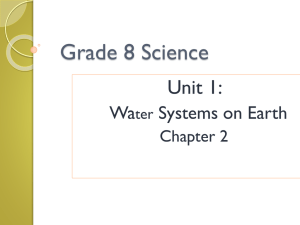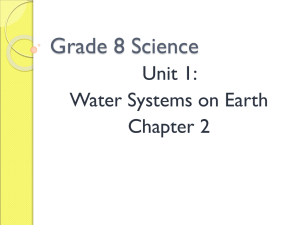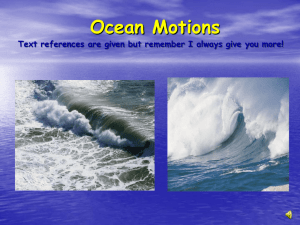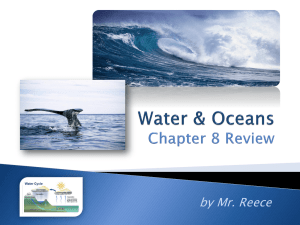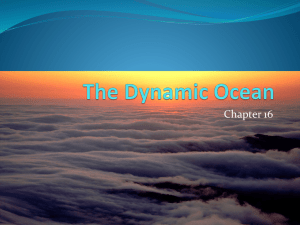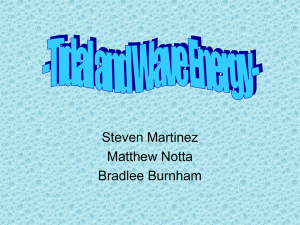Ch 21-Movements of Ocean
advertisement
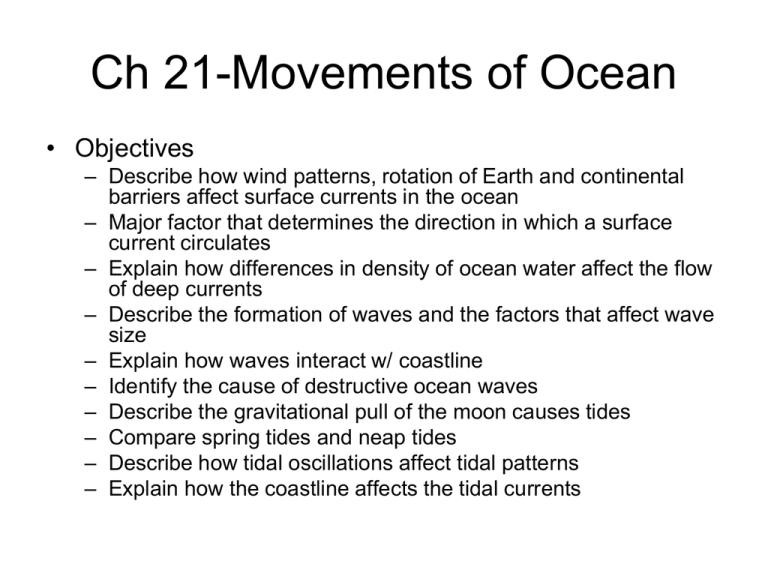
Ch 21-Movements of Ocean • Objectives – Describe how wind patterns, rotation of Earth and continental barriers affect surface currents in the ocean – Major factor that determines the direction in which a surface current circulates – Explain how differences in density of ocean water affect the flow of deep currents – Describe the formation of waves and the factors that affect wave size – Explain how waves interact w/ coastline – Identify the cause of destructive ocean waves – Describe the gravitational pull of the moon causes tides – Compare spring tides and neap tides – Describe how tidal oscillations affect tidal patterns – Explain how the coastline affects the tidal currents Factors that Affect Surface Currents • Currents-horizontal movement of water in well defined pattern • Surface currents-currents that move on or near the surface of ocean and are driven by winds – Controlled by air currents, Earth’s rotation, location of continents • What causes winds? – Uneven heating of the atmosphere – Air moves from high to low pressure – Colder, denser air sinks Global Wind Belts • Trade winds-located just N and S of equator, push currents westward • Westerlies-push ocean currents eastward in higher latitudes of N and S Hemispheres • Both affect flow of ocean surface currents Rotation and Continental Barriers • Continental barriers-current is deflected and divided when surface currents flow against continent • Coriolis Effect-apparent curving of the path of moving object from an otherwise straight path due to Earth’s rotation • Gyres-huge circle of moving ocean water found above and below the equator Major Surface Currents • Equatorial Currents-Atlantic, Pacific, Indian. 2 warm water equatorial currents moving west • Currents in S Hemisphere-Antarctic Circumpolar Current is largest, no continent interruption • Currents in N Atlantic-Gulf Stream moves along E coast of N America. Joins w/ Labrador current=N Atlantic current joins N Equatorial Current • Currents in N Pacific-similar to N Atlantic. Kuroshio current, flows northward along E coast of Asia, flows toward N America and cools drift of California Deep Currents • Stream-like movement of ocean water far below the surface, slower than surface currents, form in polar regions as cold dense water sinks and flows beneath warmer ocean water • Antarctic Bottom Water-dense, cold water sinks to bt, forms deep current. Moves slowly northward to latitude of 40 deg N • N Atlantic Deep Water-begins S of Greenland, flows southward under Gulf Stream, divides near equator. One flows northward, other flows southward over the Antarctic Bt Water • Turbidity Currents-strong current caused by under water landslide. What causes it do you think? Sec 2-Ocean Waves • Wave-periodic disturbance in a solid, liquid, or gas as energy is transmitted through the medium • Crest-highest pt of wave • Trough-lowest point between 2 crests • Wave height-vertical distance between the crest and the trough of a wave • Wavelength-horizontal distance between 2 consecutive crests or between 2 consecutive troughs • Wave period-time required for 2 consecutive wave crests to pass a given pt • Wave speed- wavelength/wave period Wave Size • What factors determine the size of wave? – Speed of wind, length of time the wind blows, and fetch – Fetch-distance that the wind can blow across open water – Swells-long, rolling waves which are similar in size, move in groups, one waves follows another – Steady high winds=waves equal great sizes – Strong and gusty=choppy water w/ waves of great heights and lengths • Whitecaps-winds blow the crest of a wave off, allows less radiation to reach the ocean Waves and Coastline • Shallow water near coastline, wave touches the ocean floor, waves slow and eventually break • Breakers-top of wave continues at same speed while bt wave slows as it comes in contact w/ bt. • Refraction-ocean waves bend directly toward the coastline in shallow water, shallow water wave travels slower than wave still in deep water • Undertows-irregular current, seldom strong • Rip current-large breakers returning to ocean through channels, cut through underwater sandbars parallel to beach • Longshore Currents-waves that approach beach at an angle Tsunamis • Most destructive wave in oceans • Not powered by wind • Giant seismic ocean waves, caused by earthquakes on ocean floor, volcanic eruptions and under water landslides • Height may be 30-40 m Sec 3-Tides • http://player.discoveryeducation.com/index.cfm?gu idAssetId=58229B2B-B806-415F-A8D5D174BB082381&blnFromSearch=1&productcode= US • Tides-periodic rise and fall of water level in the ocean and other large bodies of water • How does the gravitational pull of the moon cause tides? – Gravitational pull of moon is strongest on side of Earth nearest to moon. Ocean on Earth’s near side bulges slightly, causes high tide w/in area of bulge. Causes tidal bulge on opposite side of Earth Spring and Neap Tides • Tidal range-difference in levels of ocean water at high tide and low tide • Spring tides-Earth, sun, moon are aligned during new and full moon. Gravitational pull results in higher high tides and lower low tides • Neap tides-1st and 3rd quarter phase of moon the sun and moon are at right angles of each other, work against each other, daily tidal range is small Location and Tidal Range • • • • • • • • • • • • • • • • • • Baltimore, MD 1 foot, 8 inches Charleston, SC 5 feet, 10 inches Eastport, ME 19 feet, 4 inches Galveston, TX 1 foot, 5 inches Key West, FL 1 foot, 10 inches New London,CT 3 feet, 1 inch New York, NY 5 feet, 1 inch Portland, ME 9 feet, 11 inches San Diego, CA 5 feet, 9 inches San Francisco, CA 5 feet, 10 inches Vancouver, B.C 10 feet, 6 inches Boston, MA 10 feet, 4 inches Ft. Pulaski, GA 7 feet, 6 inches Philadelphia, PA 6 feet, 9 inches St. Petersburg, FL 2 feet, 3 inches Sandy Hook, NJ 5 feet, 2 inches Seattle, WA 11 feet, 4 inches Washington, DC 3 feet, 2 inches. Tidal Variations • What affects tidal patterns? – Size, shape, depth, and location of ocean basin • Tidal oscillations-slow, rocking motion of ocean water that occurs as tidal bulges move around ocean basins • Welcome to Discovery Education Player Tidal Currents • Movement of water toward and away from the coast, result of rise and fall of tides • Flood tide-when tidal currents flow toward the coast • Ebb tide-tidal current flow toward ocean • Slack water-no tidal current • Tidal currents strongest between 2 adjacent coastal regions • Tidal bore-river enters the ocean through long bay, tide may enter the river mouth, surge of water rushes upstream • http://player.discoveryeducation.com/index.cfm?guid AssetId=DDAA2EE0-553B-4C97-82794CBB03CB1FBC&blnFromSearch=1&productcode= US

